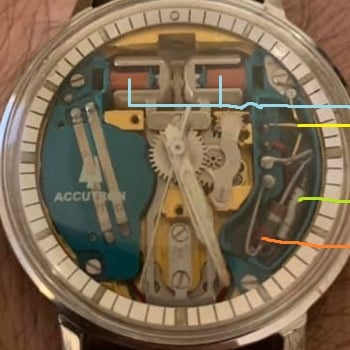Hello Everyone. I am so happy to have found this forum.
I have been a hobbyist watchmaker for some time, and want to learn more about repairing Accutrons.
I know some, but perhaps enough to be dangerous. I picked up a 1963 214 Accutron (401 variant), installed a new battery, and it is totally dead.
I "twanged" the tuning fork to see if the train wheels moved a little, which they did. Besides a bad coil, I don't know what else would make it totally unresponsive with the installation of a new battery. So, with that being said, I have posted the links to two videos. The first one is using the multimeter. I want to make sure I am touching the correct spots, correct setting, and know what I am reading.
The second video is with the Bulova Model 600 tester. I connected it to the movement per the manual and it appears to say the coil is bad.
Please...can someone give some tutelage?. Am I doing this correctly or am I off-track?. No, I am not sending the watch to a professional. I got it for the purpose of learning how to fix it myself. But, in order to do that, proper diagnosis is in order, and I want to make sure I am doing it correctly.
I nosed around YouTube and nothing of any real help. As can be seen in the first video, the multimeter is set on 200 resistance and I touched the strips of the coil assembly on the dial side and got a reading of 00.2 or 00.3
With Multimeter: https://youtu.be/G-4HvqEoB2M
With Bulova Model 600 tester: https://youtu.be/HLiYt0e_jZY
Thanks so very much.
I wish I could help. I picked up a Model 600 tester and have both working and non-working Accutrons to test which I have not figured out how to do yet. I do know that the most common issue is bad coils so it is probably the issue. Try to pick up a working one and use this as a test to see if you are doing it right.
Thanks for the reply. I'm pretty sure I know how to use the Model 600. The way I have it hooked up in the video is the way they show it in the manual. I think that's correct, but I was asking for input from someone who may be a pro at Accutrons.
The main thing is that I would like to know more about how to use a multimeter to check. Not everyone has one of these Model 600/700 Bulova testers, and multimeters are more easily obtained. I think the resistance should be more than what I am getting on the X1 setting, 00.2, which is hardly anything. Yes, I agree, I think the coil is indeed shot.
Yes, I will try the tester on a working on, but I didn't want to pop one open if I didn't absolutely have to.
I don't know anything about Accutrons, but I've worked in electronics all my life. A coil shouldn't have any noticeable resistance except for the resistance of the wire it's wound with. I doubt a multimeter would measure that. A coil has impedence that restricts the flow of AC current. Just looking at the components in an Accutron it looks like it has an LCR circuit, which consists of a coil, capacitor and resistor and is a vibrator circuit. There's probably a transistor in the circuit also that acts like a switch turning the battery power on and off. The capacitor charges when power is supplied to it and discharges through the resistor and coil when power is removed from it. The ohms of the resistor would determine how fast the capacitor discharges through the coil and the collasping magnetic field around the coil would create the impedence in the coil that would keep the transistor from turning back on until the coil has discharged it's current. It's similar to how spark plugs circuits work in cars.
In reply to I don't know anything about… by 1955mercury
In reply to I don't know anything about… by 1955mercury
"A coil shouldn't have any noticeable resistance except for the resistance of the wire it's wound with. I doubt a multimeter would measure that. " This is not quite accurate. Coils do have resistance (due to the wire, as you say) and in the case of the accutron, a significant resistance. Roughly 6K, 5K and 1K ohms. A multimeter will measure these values.
I borrowed someone's photo of their Space View on here.

The blue line is the coils.
The yellow line is the transistor. (It's a silicone transistor, but I can't tell if it's an NPN or a PNP transistor)
The green line is the capacitor. (I can't read the micro-henry value of it)
The red line is the resistor. (I can't see the color code bands well enough to determine the ohms value of it.
I can't tell how those two bars where he was hooking up the ohmeter are connected in the circuit.
This is just my humble opinion, but I think it would take years of training and experience to learn how to repair one of these and not just knowing how to hook up the multimeter correctly.
Thanks for the labeled diagram. That's cool. I am keeping that.
I figured there were resistors and capacitors in there but didn't know which was which. Regardless, I am pretty sure the coil assembly is shot in mine. I tested it against a good one using my Accutron tester and that's what it looks like. That is usually the case when they're completely dead. Years of training?. No. I've serviced a few already, but this is my first time with a bad coil. Oh, those two strips to the left of the resistor, capacitor, etc. are what I saw other people touching with the multimeter when they tested, so I was only going by that.
Actually, finding the coil assembly is the worst thing because they're no longer made, and they must be found on eBay as NOS at best, and the prices are usually not cheap. Oh well...it was fun chatting with everyone. Helpful stuff after I saw the photo.
In reply to Oh, btw, those two parallel… by DogfaceNobody
If you can find where the ends of the coils are soldered you should be able to check them individually with your ohmmeter and they should read right at "0" ohms. But they will read that if they have an internal short too. If they read higher than that, the coil wire is open somewhere and is bad. If one reads open, maybe you can buy just the one coil.
Thanks. I am pretty sure the coil is shot. The Bulova tester says so. But I am going to try to find the soldered ends like you mentioned and see what the multimeter says.
The problem is I may have to forego fixing it anyway as the replacement coils go too high on eBay. There was a 214 coil assembly on eBay that just sold for $93.
The one I have is a 214 and the coil usually comes as one unit. Thanks for all the help and advice, so I will update if I make headway.
In reply to Thanks. I am pretty sure… by DogfaceNobody
Did you watch the video that is currently featuring on the homepage?
I'm sure there is a section in the video that covers this: https://mybulova.com/videos/14454
In reply to Did you watch the video that… by mybulova_admin
Thanks. I watched that video already. They go over the usual about batteries, and moving the tines on the tuning fork a notch or two when the watch needs the time adjusted a few seconds, but nothing about multimeters and their use on the Accutron.
But...I will check it out again...maybe I missed something.
Besides, along with other Accutron tools, I have the official Bulova Model 600 tester which shows the coil is bad. I thought maybe I could test the microamps the way the Bulova tester does, but it didn't seem to work. With the tester, you stick the battery in this little nest and then connect the lead to the positive terminal in the cell hatch, and it reads the microamps. A healthy Accutron should be around 5-7 microamps, which is what my working ones read. But, this one barely moves the needle. Don't multimeters read DC microamps?. I thought I could try the same principle with the micrometer, but it didn't appear to work.
Anyway, I was just curious about the multimeter. I see videos of people using them to test quartz watches and coils, so I thought perhaps the same could be applied here. I will keep playing around with it and try the advice given.
On another note, I picked up a very nice 1967 214 Accutron on eBay recently for the same price a coil just went for...~$90
The seller said it had no battery when they got it and they never tried one. It is what it is. It may work...It may not.
Well, I took the chance and won the auction. The seller was honest because I popped in a battery and off she went!😊. Keeping good time😎. So, I have no complaints. But, this 1963 is a birthyear Accutron and I was hoping for the best, but alas, it didn't work out. It's a chance I took.
Felt good about my prior win and got too uppity.
I might cut my losses and post it back on eBay or just keep it in the hopes I'll find a coil at a sane price at some point.
By sane price, I mean <=$50, but it appears that's wishful thinking.
HI there fellow Bulova fans. Well, I ran across this site. It's the best I could find using a multimeter and showing where to place the 'trodes'. There was also a site in the UK, but it was down.
Accutron 214 Coil Assembly Testing | The Accutron Resource Forum (freeforums.net)
In reply to HI there fellow Bulova fans… by DogfaceNobody
Hi again. You may find some useful information here also.
Bulova Accutron 214 Part 2 | Electronics Repair And Technology News (jestineyong.com)
In reply to You can measure the emitter… by wimberleytech
Thanks everyone for the input. wimberley, I'm not sure what an 'emitter' is, but I found a site that shows where to touch with the leads and will give it a go. I will keep your instruction for the future.
I ended up selling the 214 in question because I could not find a coil for a sane price. I am not paying $150 + shipping. Pure greed. $50 would be fair.
Another thing I have been wondering about...is there a modern version of an Accutron timegrapher rate recorder available?. You know, back in the 60s and 70s, they had a 'rate recorder' to measure the accuracy of an Accutron, but it actually had an analog print-out. Those are now old antique collector's items if one can even find one, and I have no desire to obtain such a flathead engine anyway. Is there a modern version somewhere out there in the Universe?. Just wondering.
